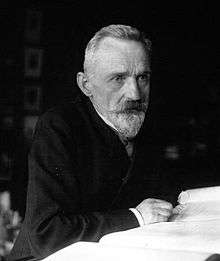Eugène Louis Bouvier
Eugène Louis Bouvier (9 April 1856, in Saint-Laurent-en-Grandvaux – 14 January 1944, in Paris) was a French entomologist and carcinologist.[1] Bouvier was a professor at the Muséum national d'histoire naturelle.

Biography
Following graduation at the normal school in Lons-le-Saunier, he taught classes in Clairvaux, Versailles, Saint-Cloud and Villefranche-sur-Saône. From 1882 to 1887, he served as a "boursier" at the Muséum national d'histoire naturelle, where he studied with Alphonse Milne-Edwards (1835–1900) and Edmond Perrier (1844–1921). Together with Milne-Edwards, he worked on some of the crustaceans from the Travailleur and Talisman expeditions (1880–1883).[1]
In 1887, he earned his doctorate in natural sciences with a dissertation involving prosobranch gastropods, Système nerveux, morphologie générale et classification des Gastéropodes prosobranches. In 1889 he became an associate professor at the Ecole supérieure de pharmacie de Paris, and in 1895, he attained a professorship of natural history (chair of "articulated animals"; starting in 1917 it was referred to as the chair of entomology) at the Muséum. Bouvier maintained the chair of entomology until 1931, when he was succeeded by René Jeannel (1879–1965).
His earlier studies dealt with evolution of various species, in particular crustaceans and mollusks. Later, he specialized in behavioral research of social insects, conducting extensive studies on the sense of smell in ants.
In 1894 he was elected president of the Société zoologique de France, and in 1897, is chosen president of the Société entomologique de France. In 1905 he participated in a scientific survey of deep-sea fauna in the Sargasso Sea. For a period time (1906–1910), he taught classes in entomology at the Pasteur Institute in Paris.
His famous work The Psychic Life of Insects (1918) was well received. In a review, the entomologist Vernon Kellogg commented that "if any one, entomologist, general zoologist or layman, would like to be able to turn to a single book in which a large range and variety of insect behavior are brought together, simply described and treated analytically with the aim not primarily of telling interesting stories, but of getting at a more fundamental understanding of the springs and control of instinct,I know of no book which can be more confidently recommended to meet this desire than the book in hand."[2]
Works
- Recherches sur les affinités des Lithodes & des Lomis avec les Paguridés (1895) – Studies on the closer relationships of the king crab Lithodes and Lomis with pagurid hermit crabs.
- Nouvelles observations sur les glaucothoés (1905) – New Observations on Glaucothoe (larvae).
- [Vie psychique des insectes] (1918) – The Psychic Life of Insects (translated, 1922).
- Habitudes et Métamorphoses des insectes (1919) – Behavior and Metamorphosis of Insects.
- Le Communisme chez les insectes (1926) – Communism Among Insects.
- Monographie des lépidoptères saturnides (1934) – Monograph of Lepidoptera, Saturniidae.
- Décapodes marcheurs de la faune de France (1940) – Decapoda of France.
Legacy
Taxa named after Bouvier include
- Procambarus bouvieri, a crayfish
- Hemidactylus bouvieri, a leaf-toed gecko
- Rissoina bouvieri, a sea snail
- Eumetula bouvieri, a sea snail
- Procolobus bouvieri, a monkey
- Cyphocaris bouvieri, an amphipod
- Cinnyris bouvieri, a sunbird
- Scotopelia bouvieri, a fishing owl
- Procambarus bouvieri, a crayfish
- Messor bouvieri, an ant
- Peripatus bouvieri, a velvet worm
See also
- List of Chairs of the Muséum national d'histoire naturelle
References
- Archives Department of the Pasteur Institute (biography)
- Hans G. Hansson. "Eugène Louis Bouvier". Biographical Etymology of Marine Organism Names. Göteborgs Universitet. Retrieved June 6, 2010.
- Kellogg, Vernon. (1923). The Psychic Life of Insects by E. L. Bouvier. Science. New Series, Vol. 58, No. 1508. pp. 423–424.